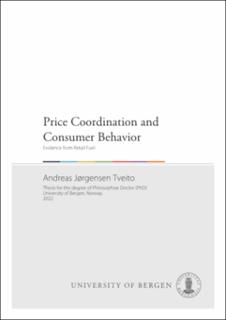Price Coordination and Consumer Behavior : Evidence from Retail Fuel
Doctoral thesis

Åpne
Permanent lenke
https://hdl.handle.net/11250/2987529Utgivelsesdato
2022-04-08Metadata
Vis full innførselSamlinger
- Department of Economics [288]
Sammendrag
This thesis consists of an introduction and three essays on price coordination and consumer behavior in the retail fuel market. Each essay includes one of the research articles that compose the principle part of the thesis. The essays use microeconometric methods and data from the Norwegian retail fuel market to investigate how firms use price leadership to coordinate more frequent price increases, the costs and benefits of price leadership, and long-run dynamics in consumers’ response to changes in the intertemporal price pattern. The introduction summarizes the essays, discusses the merits of studying firm and consumer behavior in the retail fuel market, and elaborates on policy implications of the research in the thesis.
Price leadership—a practice involving sequential price changes whereby a leader changes price first and rivals quickly follow—is commonly observed in many retail markets. The first chapter use a unique dataset spanning 14 years with the exact timing of price changes for most Norwegian gasoline stations to study price leadership and coordination in the Norwegian retail gasoline market. The market features asymmetric price cycles where prices slowly fall for several days before being restored to a high level within a few hours. The main contribution is to show how large retail chains use price leadership to both agree on and sustain a new equilibrium with more frequent price hikes. I argue that faster price changes due to a lack of price regulations in Norway can explain why the chains in Norway end up coordinating on a different equilibrium than in other countries. By combining the price data with data on volumes and costs, I estimate that the transition to more frequent price hikes has a substantial positive effect on volume-weighted retail margins.
Price leadership can bring about higher prices for all firms in the market, but can also be costly for the leader because it loses volume to rivals in the interim period when it is the sole firm with a high price. The second chapter of my thesis studies the costs and benefits of price leadership in the Norwegian retail gasoline market. The dataset with high-frequency price and volume data coupled with a particular pricing pattern allows the estimation of the costs and benefits of leading price hikes. The main result is that the leader’s volume loss from being the sole firm to raise its price until the other firms match that price increase is small compared with the large margin increases and profit gains resulting from the price jumps. Furthermore, I find that the leader is not worse off than the non-leading firms. The results can assist in explaining why firms are willing to act as regular price leaders.
Many retail markets feature intertemporal price variation caused by promotional sales, short-run wholesale price variation, or price cycles where prices fall for several days before quickly being restored to a high level. The third chapter uses 11 years of high-frequency prices and volumes for Norwegian gas stations to study the short- and long-run consumer response to price cycles with a regular low-price period at the same time every week (the sale period). I show that diesel and gasoline consumers over time increasingly fill their tanks during the sale period. Before the transition to the new price pattern, about 21% of the weekly gasoline and diesel volumes are sold in that part of the week. In the first quarter after the transition, the sale-period volume shares increase by 1–2 percentage points. In the subsequent years, the sale-period rebates remain stable while the sale-period volume shares keep rising, to total increases of 6–9 percentage points five years later. The intertemporal price elasticity increases from about -2 immediately after the transition to -6 five years later. These findings emphasize the importance of accounting for dynamics when studying consumer responses to intertemporal price variation and suggest that non-volume-weighted prices may be a poor proxy for the prices consumers pay.
